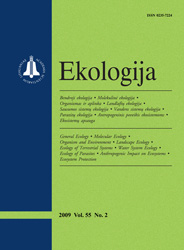 ISSN 0235-7224 ISSN 2029-0586 (online) |
2007 m. Nr. 1 The content of mineral elements in some grasses
and legumes
Mineral element (Ca, P, K, Mg, Na, Cu, Zn, Mn, Fe, Co) content in some plants, such as alfalfa (Medicato sativa), white clover (Trifolium repens), red clover (Trifolium pratense), alsike clover (Trifolium hybridum), meadow pea (Lathyrus pratensis), quack-grass (Elymus repens), meadow fescue (Festuca pratensis), red fescue (Festuca rubra), timothy (Phleum pratense), perennial ryegrass (Lolium perenne), smooth brome (Bromopsis inermis), cocks-foot (Dactylis glomerata), and meadow grass (Poa pratensis) were analyzed regarding their nutritional value. Mineral element content in the plants was found to be species- and family-dependent. Leguminous (Fabaceae) plants accumulated more Ca than cereal (Poaceae) grasses. There were no peculiarities of K and P accumulation in the plant families. Potassium content exceeded the limit nutritional value in all plants, while all of them, except white clover and quackgrass, lacked P. The legumes accumulated more Mg as compared to the grasses. All the plants, except ryegrass, lacked Na. All the plants contained sufficient amounts of Fe. The legumes had sufficient levels of Mn, while grasses, except cocks-foot, lacked it. All the plants lacked Cu and Zn. Also, the grasses were lacking in Co, while in the legumes Co levels were sufficient. On average, all the plants contained an excess of Ca, K and Fe and lacked P, Na, Zn and Cu. Grasses accumulated less Ca, Mg, Cu, Zn, Mn, Fe, Co, but more Na than the legumes. Mixtures of the study legumes and grasses in forages may optimize the content of Ca and some other mineral elements, but supplements of microelements must be applied. In order to improve the nutritional value of forages, it is essential to search for the methods of soil enrichment with mineral elements and improving the quality of forages as well as the elemental balance in the agro-ecosystems. Keywords: grasses, legumes, animal niutrition, mineral elements, elemental balance |
Issues:
2011 - Vol.57 No. 1, No. 2 2010 - Vol.56 No. 1-2, No. 3-4 2009 - Vol.55 No. 1, No. 2, No. 3-4 2008 - Vol.54 No. 1, No. 2, No. 3, No. 4 2007 - Vol.53 No. 1, No. 2, No. 2.priedas, No. 3, No. 4 2006 No. 1, No. 2, No. 3, No. 4 2005 No. 1, No. 2, No. 3, No. 4 2004 No. 1, No. 2, No. 3, No. 4 2003 No. 1, No. 2, No. 3, No. 4 2002 No. 1, No. 2, No. 3, No. 4 2001 No. 1, No. 2, No. 3, No. 4 |